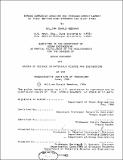Stress corrosion cracking and hydrogen embrittlement of thick section high strength low alloy steel
Author(s)
Needham, William Donald
DownloadFull printable version (24.70Mb)
Other Contributors
Massachusetts Institute of Technology. Dept. of Materials Science and Engineering.
Advisor
Ronald G. Ballinger.
Terms of use
Metadata
Show full item recordAbstract
An experimental study was conducted to evaluate the corrosion performance of weldments of a high strength low alloy(HSLA) steel in a simulated seawater environment. This steel, designated HSLA80, was developed by the United States Navy for use in ship structural applications. Stress corrosion CRACKING(SCC) and hydrogen embrittlement(HEM) were investigated by conducting 42 Wedge-Opening load(WOL) tests as a function of stress intensity and corrosion potential and 33 Slow Strain Rate(SSR) tests as a function of strain rate and corrosion potential. The corrosion potentials were chosen to simulate the environmental conditions of free corrosion, cathodic protection and hydrogen generation. The results from this investigation indicated that HSLA 80 base metal and weldments were susceptible to hydrogen assisted cracking(HAC) in a seawater environment under conditions of continuous plastic deformation and triaxial stress in the presence of hydrogen. The heat-affected zone of the weldment was found to be the most susceptible portion of the weld joint. A lower bound was established for the critical stress intensity for stress corrosion cracking for HSLA 80 base metal and weldments.
Description
Thesis (Ocean E.)--Massachusetts Institute of Technology, Dept. of Ocean Engineering; and, (M.S.)--Massachusetts Institute of Technology, Dept. of Materials Science and Engineering, 1986. 340909 Bibliography: leaves 270-277.
Date issued
1986Department
Massachusetts Institute of Technology. Department of Materials Science and Engineering; Massachusetts Institute of Technology. Department of Ocean EngineeringPublisher
Massachusetts Institute of Technology
Keywords
Ocean Engineering, Materials Science and Engineering.